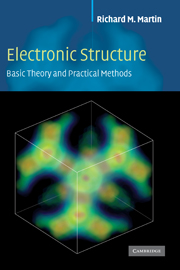Book contents
- Frontmatter
- Contents
- Preface
- Acknowledgments
- Notation
- Part I Overview and background topics
- Part II Density functional theory
- Part III Important preliminaries on atoms
- Part IV Determination of electronic structure: the three basic methods
- Part V Predicting properties of matter from electronic structure – recent developments
- 18 Quantum molecular dynamics (QMD)
- 19 Response functions: phonons, magnons, …
- 20 Excitation spectra and optical properties
- 21 Wannier functions
- 22 Polarization, localization, and Berry's phases
- 23 Locality and linear scaling O(N) methods
- 24 Where to find more
- Appendix A Functional equations
- Appendix B LSDA and GGA functionals
- Appendix C Adiabatic approximation
- Appendix D Response functions and Green's functions
- Appendix E Dielectric functions and optical properties
- Appendix F Coulomb interactions in extended systems
- Appendix G Stress from electronic structure
- Appendix H Energy and stress densities
- Appendix I Alternative force expressions
- Appendix J Scattering and phase shifts
- Appendix K Useful relations and formulas
- Appendix L Numerical methods
- Appendix M Iterative methods in electronic structure
- Appendix N Code for empirical pseudopotential and tight-binding
- Appendix O Units and conversion factors
- References
- Index
23 - Locality and linear scaling O(N) methods
from Part V - Predicting properties of matter from electronic structure – recent developments
Published online by Cambridge University Press: 05 June 2012
- Frontmatter
- Contents
- Preface
- Acknowledgments
- Notation
- Part I Overview and background topics
- Part II Density functional theory
- Part III Important preliminaries on atoms
- Part IV Determination of electronic structure: the three basic methods
- Part V Predicting properties of matter from electronic structure – recent developments
- 18 Quantum molecular dynamics (QMD)
- 19 Response functions: phonons, magnons, …
- 20 Excitation spectra and optical properties
- 21 Wannier functions
- 22 Polarization, localization, and Berry's phases
- 23 Locality and linear scaling O(N) methods
- 24 Where to find more
- Appendix A Functional equations
- Appendix B LSDA and GGA functionals
- Appendix C Adiabatic approximation
- Appendix D Response functions and Green's functions
- Appendix E Dielectric functions and optical properties
- Appendix F Coulomb interactions in extended systems
- Appendix G Stress from electronic structure
- Appendix H Energy and stress densities
- Appendix I Alternative force expressions
- Appendix J Scattering and phase shifts
- Appendix K Useful relations and formulas
- Appendix L Numerical methods
- Appendix M Iterative methods in electronic structure
- Appendix N Code for empirical pseudopotential and tight-binding
- Appendix O Units and conversion factors
- References
- Index
Summary
Nearsightedness
W. KohnThrowing out k-space
V. HeineSummary
The concept of localization can be imbedded directly into the methods of electronic structure to create new algorithms that take advantage of locality or “nearsightedness” as coined by W. Kohn. As opposed to the textbook starting point for describing crystals in terms of extended Bloch eigenstates, many physical properties can be calculated from the density matrix ρ(r, r′), which is exponentially localized in an insulator or a metal at finite T. For large systems, this fact can be used to make “order-N” or O(N) methods where the computational time scales linearly in the size of the system. There are two aspects of the problem: “building” the hamiltonian and “solving” the equations. Here we emphasize the second aspect, which is more fundamental, and describe representative O(N) approaches that either treat ρ(r, r′) directly or work in terms of Wannier-like localized orbitals.
The reader should be aware (beware) that O(N) methods are under development; there are problems and shortcomings in actual practice.
Every textbook on solid state physics begins with the symmetry of crystals and the entire subject of electronic structure is cast in the framework of the eigenstates of the hamiltonian classified in k space by the Bloch theorem. So far this volume is no exception. However, the real goal is to understand the properties of materials from the fundamental theory of the electrons and this is not always the best approach, either for understanding or for calculations.
- Type
- Chapter
- Information
- Electronic StructureBasic Theory and Practical Methods, pp. 450 - 474Publisher: Cambridge University PressPrint publication year: 2004
- 1
- Cited by



